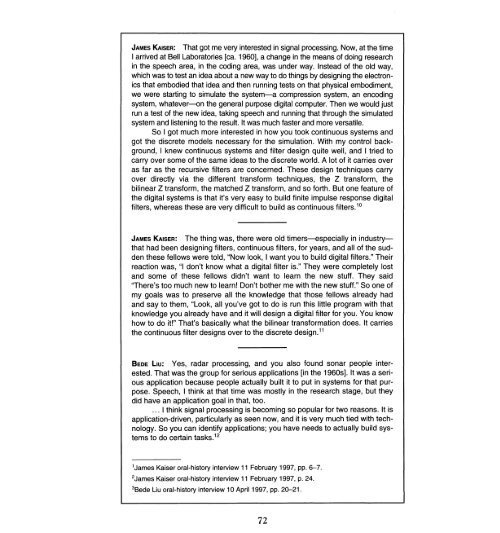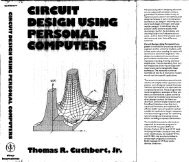Going Digital: The 1960s - IEEE Global History Network
Going Digital: The 1960s - IEEE Global History Network
Going Digital: The 1960s - IEEE Global History Network
Create successful ePaper yourself
Turn your PDF publications into a flip-book with our unique Google optimized e-Paper software.
JAMES KAISER: That got me very interested in signal processing. Now, at the time<br />
I arrived at Bell Laboratories [ca. 1960], a change in the means of doing research<br />
in the speech area, in the coding area, was under way. Instead of the old way,<br />
which was to test an idea about a new way to do things by designing the electronics<br />
that embodied that idea and then running tests on that physical embodiment,<br />
we were starting to simulate the system-a compression system, an encoding<br />
system, whatever-on the general purpose digital computer. <strong>The</strong>n we would just<br />
run a test of the new idea, taking speech and running that through the simulated<br />
system and listening to the result. It was much faster and more versatile.<br />
So I got much more interested in how you took continuous systems and<br />
got the discrete models necessary for the simulation. With my control background,<br />
I knew continuous systems and filter design quite well, and I tried to<br />
carry over some of the same ideas to the discrete world. A lot of it carries over<br />
as far as the recursive filters are concerned. <strong>The</strong>se design techniques carry<br />
over directly via the different transform techniques, the Z transform, the<br />
bilinear Z transform, the matched Z transform, and so forth. But one feature of<br />
the digital systems is that it's very easy to build finite impulse response digital<br />
filters, whereas these are very difficult to build as continuous filters. 1o<br />
JAMES KAISER: <strong>The</strong> thing was, there were old timers-especially in industrythat<br />
had been designing filters, continuous filters, for years, and all of the sudden<br />
these fellows were told, "Now look, I want you to build digital filters." <strong>The</strong>ir<br />
reaction was, "I don't know what a digital filter is." <strong>The</strong>y were completely lost<br />
and some of these fellows didn't want to learn the new stuff. <strong>The</strong>y said<br />
''<strong>The</strong>re's too much new to learn! Don't bother me with the new stuff." So one of<br />
my goals was to preserve all the knowledge that those fellows already had<br />
and say to them, "Look, all you've got to do is run this little program with that<br />
knowledge you already have and it will design a digital filter for you. You know<br />
how to do it!" That's basically what the bilinear transformation does. It carries<br />
the continuous filter designs over to the discrete design. 11<br />
Yes, radar processing, and you also found sonar people interested.<br />
That was the group for serious applications [in the <strong>1960s</strong>]. It was a serious<br />
application because people actually built it to put in systems for that purpose.<br />
Speech, I think at that time was mostly in the research stage, but they<br />
did have an application goal in that, too.<br />
... I think signal processing is becoming so popular for two reasons. It is<br />
application-driven, particularly as seen now, and it is very much tied with technology.<br />
So you can identify applications; you have needs to actually build systems<br />
to do certain tasks. 12<br />
BEDE Llu:<br />
lJames Kaiser oral-history interview 11 February 1997, pp. 6-7.<br />
2James Kaiser oral-history interview 11 February 1997, p. 24.<br />
3Bede Liu oral-history interview 10 April 1997, pp. 20-21.<br />
72
















